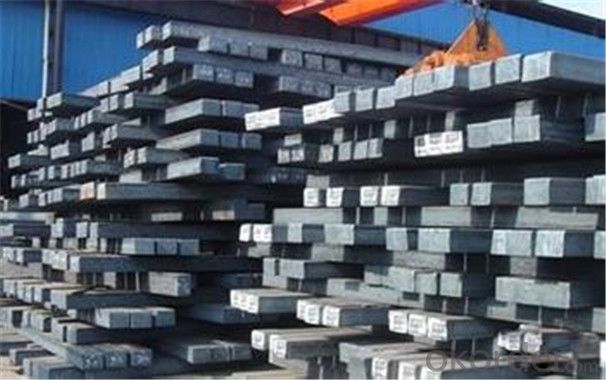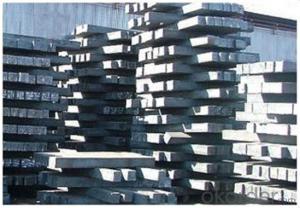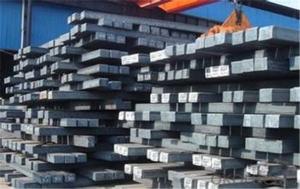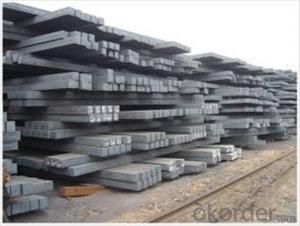Square Steel Billet Hot Sale Q275/5SP in China
- Loading Port:
- Tianjin
- Payment Terms:
- TT OR LC
- Min Order Qty:
- 500 m.t.
- Supply Capability:
- 45555555 m.t./month
OKorder Service Pledge
OKorder Financial Service
You Might Also Like
Item specifice
Description of steel billet:
Our company is recognized by ISO9001:2008
1. hot rolled wire rod
2. material: Q195-235
Festures of steel billet:
1. Drawn wire specialist, your wire rod solution
2. ISO9001 Certified Mill &SGS
3. Feature: machinability, high hardness, toughness, corrosion resistant
Specifications of steel billet:
Name: | steel billets |
LENGTH: | 6 meter to 12 meter (+ 50mm) |
Size: | 100*100, 120*120, 150*150, 200*200 |
Grade: | 3SP,5SP,Q235,20MnSi. |
Shape: | Square, Round |
Technique: | Hot-Rolled |
Standard: | ASTM/GB |
BENDING | No more than 5mm in 1 meter |
ANGULAR TWIST | No more than 1 degree per meter and not more than 6 degree over 12 meter length. |
Images of steel billet:

FAQ:
1. What is your package?
Packing situation: standard seaworthy packing or as customer required.
2. How long is the lead time?
Delivery time: 45 days after order confirmed.
3. What payment term do you accept?
Payment: T/T or L/C at sight.
- Q:What are the different types of steel wire rod processing equipment?
- There are several types of steel wire rod processing equipment, including wire drawing machines, wire straightening and cutting machines, wire mesh welding machines, and wire bending machines. Each of these equipment serves a specific purpose in the production and processing of steel wire rods, such as enhancing the wire's strength, straightening and cutting it to desired lengths, welding wires to create mesh structures, or bending them into various shapes.
- Q:What are the different annealing processes used for steel wire rod?
- The different annealing processes used for steel wire rod include full annealing, spheroidization annealing, and process annealing. Full annealing involves heating the wire rod to a temperature above its critical temperature and then slowly cooling it to room temperature to soften it and improve its ductility. Spheroidization annealing is a type of full annealing that is specifically used for high carbon steel wire rod to transform its brittle cementite structure into spherical carbides, enhancing its machinability and reducing the risk of breakage. Process annealing, on the other hand, is a partial annealing process that is performed on cold-worked wire rod to relieve internal stresses and restore some of its ductility without affecting its mechanical properties.
- Q:What are the different surface defects that can impact the corrosion resistance of steel wire rod?
- Some of the different surface defects that can impact the corrosion resistance of steel wire rod include pits, scratches, scales, and coatings. These defects can create areas of weakness on the surface of the wire rod, making it more susceptible to corrosion.
- Q:What are the common joining methods for steel wire rod?
- The common joining methods for steel wire rod include welding, soldering, crimping, and using mechanical connectors such as bolts or clips.
- Q:How is steel wire rod used in the manufacturing of wire mesh?
- Steel wire rod is used in the manufacturing of wire mesh as it serves as the primary raw material. The rod is first drawn through a series of dies to reduce its diameter and increase its length. This process is known as wire drawing. The resulting wire is then woven or welded together to form a mesh pattern, creating a durable and versatile product used in various applications such as fencing, construction, and industrial purposes.
- Q:How does the yield strength of steel wire rod vary with different grades?
- The yield strength of steel wire rod can vary significantly with different grades. Steel wire rod is produced in various grades, each with its own unique composition and heat treatment process. The yield strength refers to the amount of stress a material can withstand before it begins to deform permanently. Different grades of steel wire rod are designed to have specific mechanical properties to meet the requirements of different applications. Generally, higher grades of steel wire rod have higher yield strengths. This is achieved by adjusting the chemical composition and heat treatment processes during manufacturing. For example, low carbon steel wire rod grades typically have lower yield strengths and are commonly used in applications where flexibility and ductility are important, such as in wire mesh and fencing. On the other hand, high carbon steel wire rod grades are known for their high yield strengths and are used in applications that require greater strength and durability, such as in automotive parts and construction materials. The yield strength of steel wire rod can also be influenced by other factors such as the size and shape of the rod, the presence of alloying elements, and the manufacturing process. It is important to consider these factors when selecting the appropriate grade of steel wire rod for a specific application to ensure optimal performance and safety.
- Q:How are steel wire rods used in the manufacturing of electrical conductors?
- Steel wire rods are used in the manufacturing of electrical conductors by being drawn into thin wires, which are then used to create the core of the conductor. The steel wire rods provide strength and durability to the conductor, ensuring it can carry electrical current efficiently and safely.
- Q:What are the main challenges in manufacturing steel wire rod?
- Manufacturing steel wire rod presents several primary challenges. Consistent quality and uniformity in production prove to be one of these challenges. This necessitates strict control over the steel's chemical composition and mechanical properties, as any deviation can impact the final product's performance and reliability. Consequently, adherence to quality control procedures and continuous monitoring throughout the manufacturing process become essential. Another hurdle is achieving the desired dimensional accuracy and surface finish of the wire rod. This requires precise regulation of temperature and speed during the rolling process to ensure proper shape and size. Any irregularities or defects in the wire rod can compromise its strength and durability, rendering it unsuitable for intended applications. Balancing high production rates with safety and minimizing downtime also poses a significant challenge. Complex machinery and equipment used in steel wire rod manufacturing necessitate regular maintenance and monitoring to prevent breakdowns. Additionally, ensuring worker safety in this environment requires the implementation of strict safety protocols and the provision of appropriate safety equipment. Environmental sustainability is yet another challenge in steel wire rod manufacturing. The production process consumes substantial energy and emits greenhouse gases. To reduce the industry's environmental impact, energy-efficient technologies must be implemented, waste materials should be recycled and reused, and sustainable practices adopted throughout the entire production chain. Moreover, the steel wire rod industry faces the challenge of increasing competition and fluctuating market demands. Manufacturers must remain up-to-date with market trends, adapt to changing customer requirements, and constantly innovate to stay competitive. This involves investing in research and development to enhance product quality, develop new alloys, and explore alternative manufacturing methods. In conclusion, addressing challenges related to quality control, dimensional accuracy, safety, environmental sustainability, and market competitiveness is crucial in manufacturing steel wire rod. Overcoming these challenges requires a combination of advanced technology, a skilled workforce, and continuous improvements in manufacturing processes.
- Q:What are the main factors affecting the machined surface finish of steel wire rod?
- The main factors affecting the machined surface finish of steel wire rod are the quality and condition of the cutting tool, the speed and feed rate of the machining process, the lubrication used during machining, the hardness and composition of the steel wire rod, and the stability and rigidity of the machine tool.
- Q:How is the chemical composition of steel wire rod analyzed?
- The chemical composition of steel wire rod is typically analyzed using various laboratory techniques such as spectroscopy, X-ray fluorescence (XRF), and optical emission spectroscopy (OES). These methods involve exposing the wire rod to high energy sources or chemical reactions to determine the presence and concentration of different elements in the steel. By analyzing the chemical composition, manufacturers can ensure that the steel wire rod meets the required standards and specifications for its intended applications.
1. Manufacturer Overview |
|
|---|---|
| Location | |
| Year Established | |
| Annual Output Value | |
| Main Markets | |
| Company Certifications | |
2. Manufacturer Certificates |
|
|---|---|
| a) Certification Name | |
| Range | |
| Reference | |
| Validity Period | |
3. Manufacturer Capability |
|
|---|---|
| a)Trade Capacity | |
| Nearest Port | |
| Export Percentage | |
| No.of Employees in Trade Department | |
| Language Spoken: | |
| b)Factory Information | |
| Factory Size: | |
| No. of Production Lines | |
| Contract Manufacturing | |
| Product Price Range | |
Send your message to us
Square Steel Billet Hot Sale Q275/5SP in China
- Loading Port:
- Tianjin
- Payment Terms:
- TT OR LC
- Min Order Qty:
- 500 m.t.
- Supply Capability:
- 45555555 m.t./month
OKorder Service Pledge
OKorder Financial Service
Similar products
New products
Hot products
Hot Searches
Related keywords




























